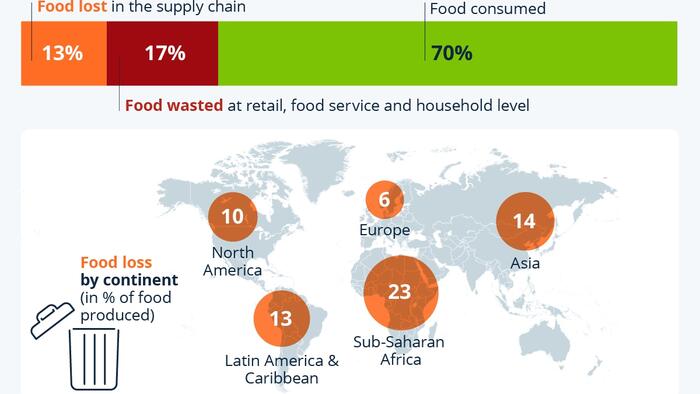Around the world, 30 percent of food which is produced is never eaten.
While 13 percent perishes or is discarded before it even reaches supermarkets or restaurants (so-called food loss), consumers, retail and food service businesses leave another 17 percent unused (referred to as food waste).
This is according to data by the UN Food and Agriculture Organization and the UN Environment Programme.
The shockingly high number means that one billion meals are wasted every day at the household level and that food loss and waste account for an estimated 8-10 percent of global greenhouse gas emissions. The UN and the FAO have been tracking food loss since 2015 and have found that its levels have not changed much. Data on food waste has not been collected consistently enough to make any judgements about changes in recent years (even though some countries have reported improvements). September 29 marked the International Day of Awareness of Food Loss and Waste.
As Statista’s Katharina Buchholz details below, food losses are particularly high for fruits and vegetables (25.4 percent lost), followed by meats and animal products (14 percent). Losses occur due to incorrect harvesting times, climatic conditions, incorrect harvesting techniques, poor storage and improper transport. Developing countries are particularly affected by these issues as Sub-Saharan Africa struggles with losses of almost a quarter of available foods, compared to 14 percent in Asia, 10 percent in North America and just 6 percent in Europe.
You will find more infographics at Statista
Food waste, on the other hand, was traditionally associated with high-income countries, but this gap has been closing. As of 2022, food waste per capita varied little between high income, upper-middle income and lower-middle income nations. According to the UN, this is due to the rapid development and urbanisation of countries in the Global South, for example India and China. While sufficient data lacked on low income nations overall, country-level data shows that even among this group of nations, food waste amounts varied significantly. Some of the countries reporting the least food waste were on the territory of the former Soviet Union or located in Eastern Europe.
Households are the biggest culprits for food waste as they are responsible for around 60 percent of it. Waste continues to happen as consumers of all income levels, especially those in cities, lack food management skills and rely on deep-seated habits and beliefs rather than knowledge around the edibility of foods.
Loading recommendations…











